This is how I imagine my ideal readers: they’re in a reclining chair, maybe sipping on warm tea. Poring over my words with great attention. Occasionally chuckling to one of my bon mots.
But I have to scrap that.
Because the average reader only goes over 20% of the content on website pages. That’s right! Four out of five written sentences will be completely ignored.
Why? Well, be honest about how you read yourself. You’re probably distracted. You have dozens of browser tabs opened at the same time. You’re skimming text on a small phone screen while waiting for a train.
However, that doesn’t mean writers should abandon all hope. We just have to agree that writing for the web requires a completely new mindset.
And yes, your words still do matter. A lot.
Why Writing for the Web is Important
You’ve heard marketers claim that “content is king”. But why exactly? There are a number of reasons, not all of which are about selling stuff to visitors.
SEO or Search Engine Optimization
This is a huge one. Essentially, search engines like Google send little robots to scan web pages. These crawlers, as they’re called, extract concepts through data to get an idea of what kind of page it is. The “better” that page is, the higher Google will rank it in its search results.

But what makes a page better than another? Well it’s not entirely clear, and certainly not officially announced by Google. But most SEO specialists believe the company measures quality through various metrics, including:
- How long do users spend on the page?
- Does the page actually satisfy the visitors intent, whether it’s an (ecommerce) transaction or an informational search?
- Do they click through a link to go to another page?
- Are they engaging through comments?
Essentially, they try to read human behavior.
And while tricks and techniques exist to fool crawlers, one thing is for sure: the better quality the content is, the more it will help SEO “organically” – that is to say, through real user visits will real good intentions. That’s something Google loves.
Giving Authority To Your Website
Good content makes your website, brand or organization credible. Adding a blog or pages of text helps readers feel like you know your stuff. It projects an image of being professional and active – especially with regular blog posts.
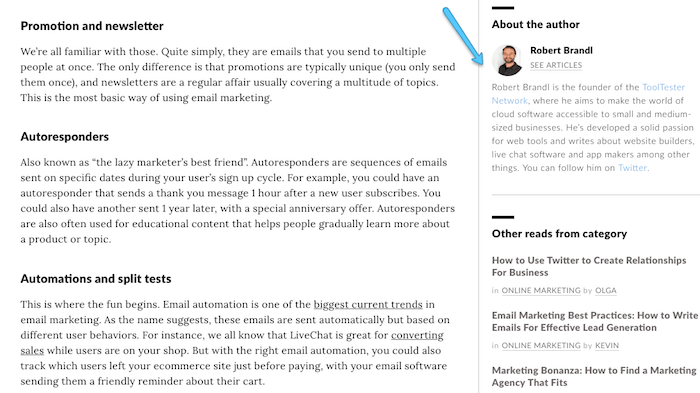
Adding a headshot and some text about you increases your credibility.
Of course, it’s also a tremendous boost for ecommerce. If you’re selling a product or service online, people want a seal of trust. Having quality content that answers questions before they buy is the first step towards converting customers.
Engaging With Your Audience
What do you get at the end of a good article? Comments! Sometimes for the best and for the worst. But comments are a great way to get feedback on your writing and understand who your audience is.
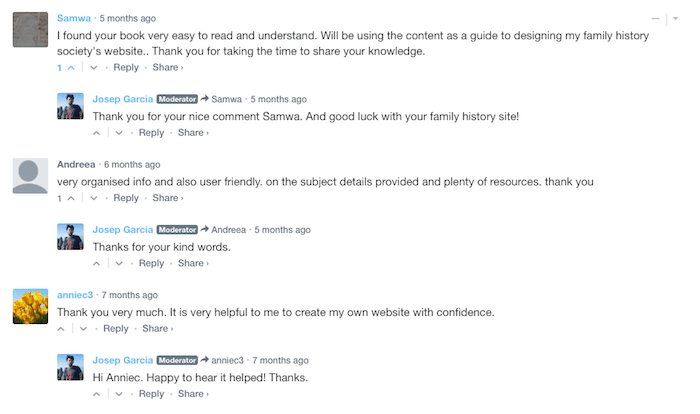
Some comments here at Tooltester.com
Also: engagement is one of those metrics search engines may measure to help raise or lower your ranking. Both on your website, and cross-referenced with your social media interactions.
On our website, for instance, these interactions often lead to actual content improvements. Our visitors often spot outdated information and suggest additions to our articles. So it’s a win-win.
Finding Your Voice in An Online World
Maybe you don’t care about search engines or sales at all. Maybe you just want to develop a voice, for a brand or for yourself. Or to share what you know with the world. Unfortunately, no matter how earnest you are, online audiences’ behavior will be the same. They’ll want information, and they’ll want it fast. Which lets me segue into the new rules of web writing.
The Rules of Writing for the Web
1. Understand Reader Behavior
We already know people typically only read 20% of the page. But how do they read it? Understanding readers is the first step to becoming a better web writer yourself. This is what research shows in common reader behavior online:
- Read page title and a few words of the intro
- Scroll down, scroll down
- Scan for a few key sentences
- Scroll all the way down to see how long the article is
- Maybe go back to the top and read more thoroughly
This means important information has to come fast. And I don’t mean in the first paragraph. I mean as early as the title. Readers must be 100% certain they are on the right page, and as soon as possible.
2. Be CTA-Focused
CTA stands for Call To Action. Essentially, think of it as the verb that describes what you want readers to do once they’re done with your article. Most common CTAs include:
- Sign up to our mailing list
- Buy this awesome product
- Let me know what you think
- Follow me on social media
- Etc…
While you can have several buttons or links for your CTA on the page, it’s a good rule to focus on one goal per page. You don’t want to send users left and right through a thousand external URLs. Keep it focused.
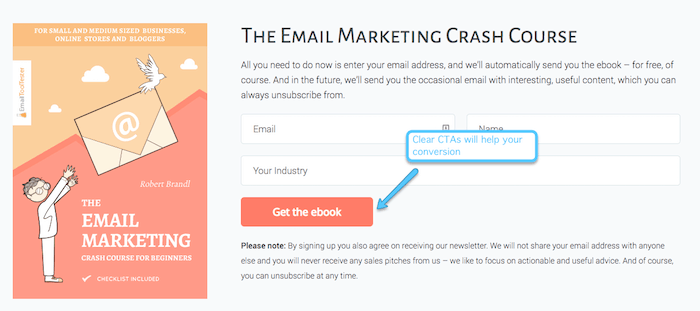
And yes, sometimes, there won’t be an immediate call to action. You just want users to remain on your page as long as possible, which is why it helps to structure information efficiently – by thinking of text as a visual medium.
3. Think of text Visually
Now that we understand what you want to achieve and how people read, we can meet halfway. Let’s try to make the page as easy to digest and efficient as possible. This is done through:
- Bulleted lists: such as this one. They help break down the information on the page into digestible chunks.
- Headers: give a clear structure to your text (and also help with SEO).
- Go bold: helps highlight the important information for skimmers.
- Look at the negative space: or whitespace on the page. This helps avoid huge walls of text and long sentences. Break it down into smaller sections whenever possible.
- Fonts matter: You want the text to be legible and pleasant to look at. On all devices and screen sizes!
- Extra media: add images, graphics, and even videos to break down the text.
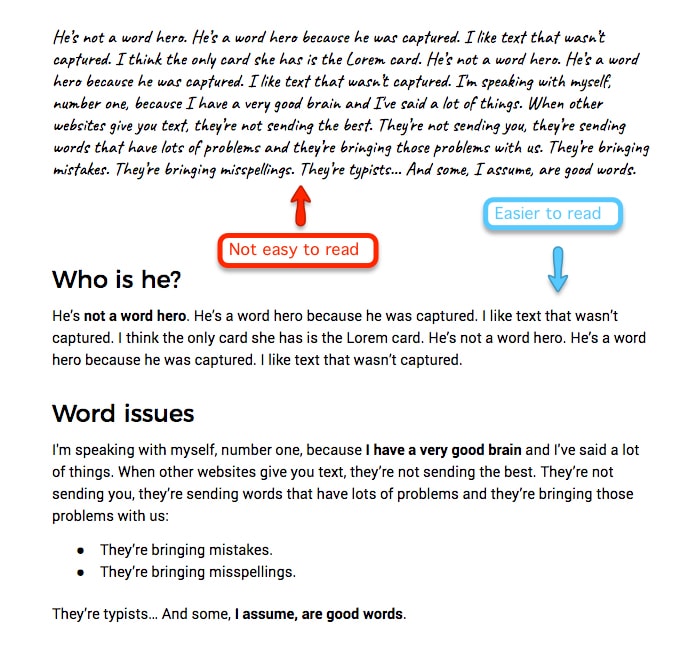
Bad and good examples of writing for the web
Quotes, infographics, nice paragraph separators. Anything goes as long as your page is beautiful to look at. It helps if you have a good understanding of visual design, but even if you don’t, try to scroll up and down your content: does it look dense with words and intimidating, or does it feel airy and digestible?
4. Research, Research, Research
Good content has to be engaging, useful, and unique. Which is why it helps to spend a long time researching your topic. It’s not unlikely for content writers to spend half the time reading articles from competing websites before they begin typing one word.
But it’s not just about competition, good content is drafted, edited, rewritten and restructured through multiple iterations. The planning stage can be overwhelming, but it’s also exciting. After all, you can’t go wrong on a first draft. It’s just about researching ideas and planning your structure.
Research is also about discovering your audience. Research who they are and why they land on your site. Use analytics. See what sticks and what drives them away.
Oh, and last but not least, make sure you research the right keywords – if your target is SEO… Speaking of which:
5. Learn SEO Basics
SEO is a minefield. It’s a complicated, ever-changing topic. For instance, when I started as a content writer a few years ago, a lot of clients checked keyword density. Today, it’s not only an obsolete technique, it can actually hurt to “stuff” keywords in your content.
So it’s no surprise there are conferences everywhere around the world for people who try to wrap their heads around the best optimization techniques.
You probably don’t need to become a full-time specialist. But a basic understanding of SEO will help a ton. At the top of my head, that includes:
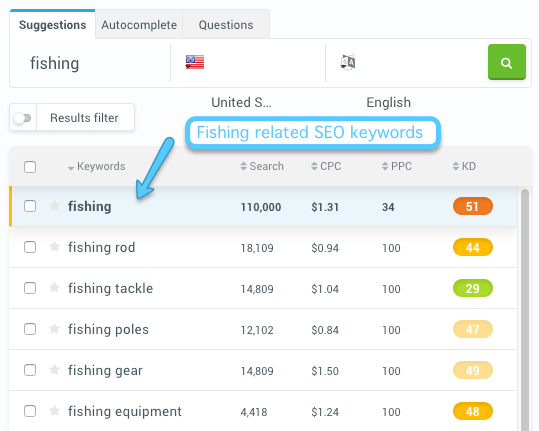
Source: KWfinder
- Keyword research: know what your audience is searching for and what words they use to describe their query (Answer The Public is a great free research tool).
- Proper formatting: Headers with the right keyword
- Meta title and descriptions: The text that appears in the search engine
- Links: backlinks, links to high authority websites, and internal links.
- Word count: here again, there is no magic number. It’s really about covering your topic in detail. This could be 250 words for an ecommerce product, or 2000+ words for in-depth guides (like this one). It’s best to check what is currently ranking on Google to get an idea about how detailed your content should be.
- And the last interesting thing I read on SEO, which is about how Google values Expertise, Authority, Trustworthiness (E.A.T.). Worth keeping in mind if you’re starting a new website.
Finally, to learn more about the basics, I’d recommend this excellent guide on SEO written by my colleague Josep.
6. Become a Better Writer
Just because readers only digest one-fifth of your sentences doesn’t mean you can half-arse it. Improving your writing skills is a lifelong goal, but a few tips and techniques always seem to work, whether it’s when writing novels or dumb listicles:
- Write in the active voice: it makes your text more impactful. I’ll let the excellent Grammar Girl teach you all about it here if you need a refresher.
- Spellcheck: use your word processor tools. Enlarge the text bigger or read it aloud to spot anything that sounds weird.
- Keep it simple: unless your audience is super technical, it’s best to avoid jargon. Or at least, don’t be scared to explain what the acronyms mean or to define complex terms.
- Avoid repetitions: thesaurus is your best friend here, but don’t abuse obscure synonyms for the sake of it.
- Edit multiple times: ask a friend or colleague to help. Take a break before you re-read. Or check Fiverr for proofreaders and editors.
Also, try to be honest about your strength and weaknesses. For instance, I’m not great at grammar and finding strong verbs. So I try to keep it in mind during my second or third round of edits. It helps.
And finally, here’s my favorite advice ever. It’s from Gary Provst, and it demonstrates perfectly why and how good writing works in action:
“This sentence has five words. Here are five more words. Five-word sentences are fine. But several together become monotonous. Listen to what is happening. The writing is getting boring. The sound of it drones. It’s like a stuck record. The ear demands some variety.
Now listen. I vary the sentence length, and I create music. Music. The writing sings. It has a pleasant rhythm, a lilt, a harmony. I use short sentences. And I use sentences of medium length. And sometimes, when I am certain the reader is rested, I will engage him with a sentence of considerable length, a sentence that burns with energy and builds with all the impetus of a crescendo, the roll of the drums, the crash of the cymbals–sounds that say listen to this, it is important.”
7. Adapt Your Tone
If you spend a lot of time online, you’ll notice most article these days have a similar tone. It’s like a “blog voice”. It’s casual, and friendly, and usually written in the first person. In short, it’s completely different from what we were taught in school.
It’s also the tone I use in this article. But it’s not always the one you should employ. For instance, if you write blog posts for a law practice, you’ll want to project more professionalism and authority. If you’re writing for a gadget shop, then yes ok, it can be playful and silly.
Now I won’t go into the details of how to craft your tone (that’s a whole article in and of itself), but just keep your voice in mind depending on your audience.
8. Use Text Analysis Tools
Robots are going to take our jobs. It’s only fair to use them before they start using us. Aside from the regular spell check and word count tools, there are a few third party services I tend to rely on:
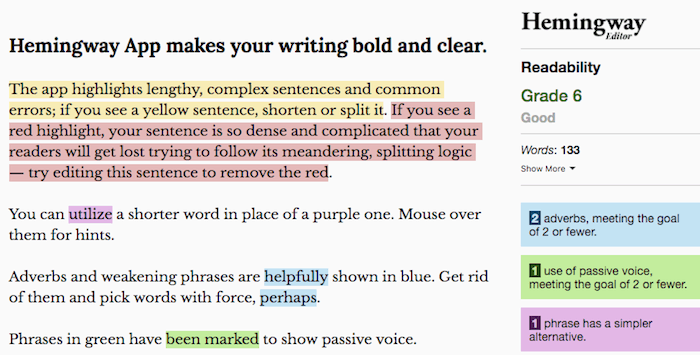
Source: Hemingway editor
- Hemingway: a cool site that helps with readability and grammar issues. Don’t go crazy with it though, or you end up sounding like a robot.
- Grammarly: the free writing assistant is everywhere these days, and their grammar-improving AI is pretty good.
- Copyscape: search engines frown upon plagiarism, so you might want to check whether content you have not written yourself is 100% unique.
- SERP optimization tool: lets you preview meta titles and descriptions in Google search results. And they always update it to match the latest Google requirements.
- Yoast SEO: an excellent WordPress plugin that gives you pointers towards improving your on-page SEO.
You can even take this one step further and use AI writing tools like Chat GPT to help you create content. Just don’t make the mistake and use it unedited (always check it for logic and style!).
Conclusion: Writing For The Web
So yes, in the end, writing for the web might mean re-learning how to write entirely. But chances are you probably already know how. If you understand what kind of blog posts, articles and news sites you enjoy, you’re already halfway there.
Finally, just remember that becoming a writer also means becoming a better reader. And hopefully, this article was useful enough that you’ve have read more than 20% of it!
We keep our content up to date
25 Jan 2023 - Smaller updates and additions
THE BEHIND THE SCENES OF THIS BLOG
This article has been written and researched following a precise methodology.
Our methodology

